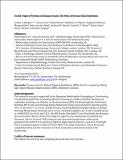Files in this item
On the origin of proteins in human drusen : the meet, greet and stick hypothesis
Item metadata
| dc.contributor.author | Bergen, Arthur A. | |
| dc.contributor.author | Arya, Swati | |
| dc.contributor.author | Koster, Céline | |
| dc.contributor.author | Pilgrim, Matthew G. | |
| dc.contributor.author | Wiatrek-Moumoulidis, Dagmara | |
| dc.contributor.author | van der Spek, Peter | |
| dc.contributor.author | Hauck, Stefanie M. | |
| dc.contributor.author | Boon, Camiel J. F. | |
| dc.contributor.author | Emri, Eszter | |
| dc.contributor.author | Stewart, Alan J. | |
| dc.contributor.author | Lengyel, Imre | |
| dc.date.accessioned | 2019-12-17T00:36:36Z | |
| dc.date.available | 2019-12-17T00:36:36Z | |
| dc.date.issued | 2019-05 | |
| dc.identifier | 256923572 | |
| dc.identifier | f8366305-d4a2-4250-a596-a71e0b6695a9 | |
| dc.identifier | 85059867049 | |
| dc.identifier | 000472688300003 | |
| dc.identifier.citation | Bergen , A A , Arya , S , Koster , C , Pilgrim , M G , Wiatrek-Moumoulidis , D , van der Spek , P , Hauck , S M , Boon , C J F , Emri , E , Stewart , A J & Lengyel , I 2019 , ' On the origin of proteins in human drusen : the meet, greet and stick hypothesis ' , Progress in Retinal and Eye Research , vol. 70 , pp. 55-84 . https://doi.org/10.1016/j.preteyeres.2018.12.003 | en |
| dc.identifier.issn | 1350-9462 | |
| dc.identifier.other | ORCID: /0000-0003-4580-1840/work/60195799 | |
| dc.identifier.other | ORCID: /0000-0001-7978-9507/work/61370156 | |
| dc.identifier.uri | https://hdl.handle.net/10023/19143 | |
| dc.description | This research was part-supported by de Algemene Nederlandse Vereniging ter Voorkoming van Blindheid (ANVVB), de Stichting Blinden-Penning, de Gelderse Blinden Stichting, de Landelijke Stichting voor Blinden en Slechtzienden (LSBS), Stichting Oogfonds Nederland, Stichting MD Fonds and Stichting Retina Nederland Fonds (represented by Uitzicht, grants 2011-6 and 2014-7 to A.A.B.), de Rotterdamse Stichting Blindenbelangen (RSB), de Haagse Stichting Blindenhulp, Stichting Lijf en Leven, Stichting voor Ooglijders (to A.A.B.); ZonMW grant nr 446001002 (to A.A.B. and C.K.); the Bill Brown Charitable Trust, Moorfields Eye Hospital Special Trustees, Mercer Fund from Fight for Sight, the Eye-Risk project funded by the European Union’s Horizon 2020 research and innovation programme under grant agreement No 634479 (I.L. and E.E.), Fight for Sight project grant (I.L. and A.S.), the Bright Focus Foundation grant nr M2015370 (to SMH). | en |
| dc.description.abstract | Retinal drusen formation is not only a clinical hallmark for the development of age-related macular degeneration (AMD) but also for other disorders, such as Alzheimer's disease and renal diseases. The initiation and growth of drusen is poorly understood. Attention has focused on lipids and minerals, but relatively little is known about the origin of drusen-associated proteins and how they are retained in the space between the basal lamina of the retinal pigment epithelium and the inner collagenous layer space (sub-RPE-BL space). While some authors suggested that drusen proteins are mainly derived from cellular debris from processed photoreceptor outer segments and the RPE, others suggest a choroidal cell or blood origin. Here, we reviewed and supplement the existing literature on the molecular composition of the retina/choroid complex, to gain a more complete understanding of the sources of proteins in drusen. These “drusenomics” studies showed that a considerable proportion of currently identified drusen proteins is uniquely originating from the blood. A smaller, but still large fraction of drusen proteins comes from both blood and/or RPE. Only a small proportion of drusen proteins is uniquely derived from the photoreceptors or choroid. We next evaluated how drusen components may “meet, greet and stick” to each other and/or to structures like hydroxyapatite spherules to form macroscopic deposits in the sub-RPE-BL space. Finally, we discuss implications of our findings with respect to the previously proposed homology between drusenogenesis in AMD and plaque formation in atherosclerosis. | |
| dc.format.extent | 30 | |
| dc.format.extent | 4396945 | |
| dc.language.iso | eng | |
| dc.relation.ispartof | Progress in Retinal and Eye Research | en |
| dc.subject | Drusen proteins | en |
| dc.subject | Retinal pigment epithelium (RPE) | en |
| dc.subject | Bruch's membrane | en |
| dc.subject | Blood | en |
| dc.subject | Age-related mancular degeneration (AMD) | en |
| dc.subject | Alzheimer's disease | en |
| dc.subject | QH301 Biology | en |
| dc.subject | RB Pathology | en |
| dc.subject | RE Ophthalmology | en |
| dc.subject | DAS | en |
| dc.subject | BDC | en |
| dc.subject.lcc | QH301 | en |
| dc.subject.lcc | RB | en |
| dc.subject.lcc | RE | en |
| dc.title | On the origin of proteins in human drusen : the meet, greet and stick hypothesis | en |
| dc.type | Journal article | en |
| dc.contributor.sponsor | Fight for Sight | en |
| dc.contributor.institution | University of St Andrews. Cellular Medicine Division | en |
| dc.contributor.institution | University of St Andrews. School of Medicine | en |
| dc.contributor.institution | University of St Andrews. Biomedical Sciences Research Complex | en |
| dc.contributor.institution | University of St Andrews. Institute of Behavioural and Neural Sciences | en |
| dc.identifier.doi | 10.1016/j.preteyeres.2018.12.003 | |
| dc.description.status | Peer reviewed | en |
| dc.date.embargoedUntil | 2019-12-17 | |
| dc.identifier.grantnumber | 1586 / 1587 | en |
This item appears in the following Collection(s)
Items in the St Andrews Research Repository are protected by copyright, with all rights reserved, unless otherwise indicated.

